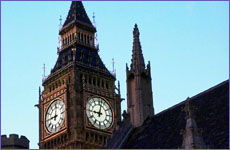 |
 |
 |
|
|||
|
London Markets
Before leaving for London recently, I went to see my friend, Allen. His apartment is filled with beautiful things he's collected from all over the world, and I wanted his advice on antique shopping. Allen has a great eye - and he's a real bargain hunter. So when I asked him what I could expect from the famous antique markets of London, he led me into his dining room. Allen: "Well, you see this oak biscuit box. It was the custom of well-appointed, English houses to have an airtight container for biscuits to put in the guest room in case one's houseguest woke up in the middle of the night feeling slightly peckish. You can see that this particular biscuit box was made in the shape of a barrel, with the rings around the barrel made of silver. I use it, not for biscuits, but for ice." This was just what I wanted: insider tips on finding unusual, inexpensive things to keep or give as gifts. Allen told me his secret. Avoid the crowded and pricey markets of Portobello Road and Camden Passage. Go instead to the Bermondsey Market, in a not-yet-gentrified area of South London. It sounded good. But I wondered: Are the vendors honest, the prices fair? What should I watch out for? Allen: "Perhaps the thing one should be most careful about is self-delusion. It's highly unlikely that one is going to happen upon a rare, undiscovered masterpiece that the Metropolitan Museum or the Victoria and Albert might have missed on their stroll through the market earlier that day." A week later, in pre-dawn gloom, I boarded the spanking new Jubilee tube line and headed for Bermondsey. When I arrived at the market it was still dark. And wet, and blustery. The plastic tarps over the stalls crackled in the wind. But there it all was, just as Allen had described. Allen: "...small ice buckets and serving trays, magnifying glasses and towel racks and letter openers, and old eyeglass cases of the art deco period, toast racks, sewing baskets . . . " As I wandered from stall to stall, I thought I saw some real bargains, but there were so many things, I began to feel overwhelmed. So I turned away from the tables laden with toast forks and sugar tongs, to an area that seemed to feature, well, odds and ends. Suddenly, on a table littered with old helmets and swords, I made a discovery. But, what was it? Vendor: "The lady seems to think it's a dodo, but I think it's a duck." It seemed like lot of money, but this was a rare find! Maybe it was the only dodo left outside of a museum! Then I remembered Allen's advice, to avoid self-delusion. And there was something odd about this bird. McNamee: "Are those the original feathers, really?" I bought him on Monday morning. I went up to Yorkshire to buy some swords and the gentleman I was buying the swords from, I said to him, I said, 'I've got a dodo in the van,' and he didn't believe me, so I said 'I'll bet you five pounds I have' and so he says, 'yeah, ok.'" I didn't buy the bird with the dodo bones and the ostrich feathers. But I did take home some letter openers and an ivory-handled butter knife with an etched blade. It's charming, even though the blade is ever so slightly bent. I got it from a lovely woman who told me all about silver hallmarks and her entire life story. Later that day, as I walked by some of the toney antique shops in Mayfair, it struck me. If you're serious about antique shopping in Britain, you can always go to the big fair at Wembley, or the well known stalls in Portobello Road. But Bermondsey Market offers the traveler more than antiques. It gives you rare chance to meet real people, who speak English and love to chat. You may go there to shop, but it seems to me that the people are the real treasures. In London, I'm Elizabeth Yates McNamee for the Savvy Traveler. Bermondsey Market is open on Fridays, beginning at about 5 a.m. until
about lunchtime, say 1:00. Get there early, they say, and you'll get
the best deals.
|
 | American Public Media Home | Search | How to Listen ©2004 American Public Media | Terms of Use | Privacy Policy |
